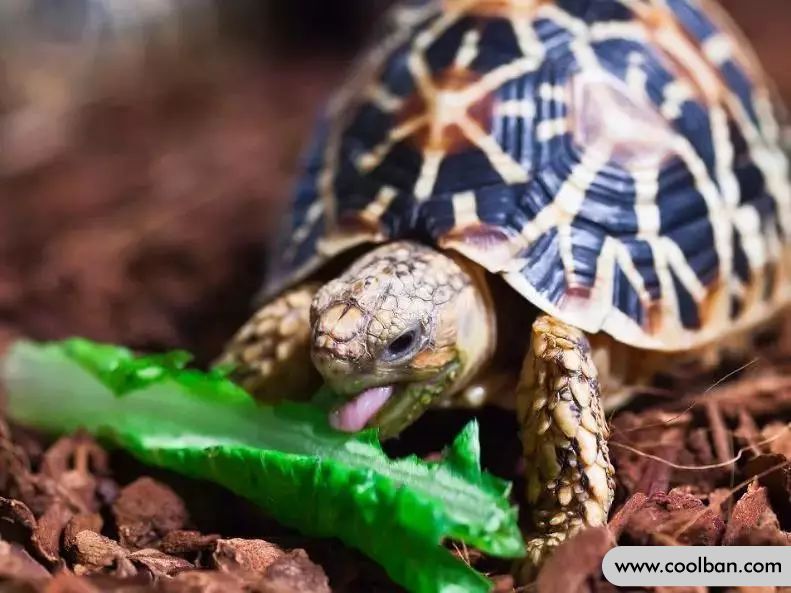Feeding of Indian star tortoises
The Indian star tortoise is a species of tortoise that is more affected by the environment, but it is a difficult tortoise to keep. This is not because the Indian star tortoise gets sick, but because it usually dies suddenly. We can treat it slowly, but there is nothing we can do about sudden death.
Morphological characteristics of the Indian star tortoise
The carapace of the Indian star tortoise is very distinctive. The seemingly identical radial lines are really the key to distinguishing this turtle. Indian star tortoises often have kyphosis, and this morbid appearance can make it even more peculiar, but this is something breeders should avoid.
The star tortoise is the smallest of the tortoises. According to the thickness of the pattern, it can be divided into Indian star tortoise and Sri Lankan star tortoise. The former has a thinner star pattern with the same thickness at the head and tail; the latter has thicker lines and enlarged ends. The rice star pattern is a protective color in origin, and it is difficult for predators to find star tortoises in the hay. It gets its name from the fact that each scale on its carapace has a star-shaped pattern. There are more than 8 lines in a shield, but in smaller numbers in hatchlings, the same pattern is also found in the plastron. Its stick-like limbs are typical tortoise limbs, so it spends a lot of time crawling and digging.
The normal uplift of the adult tortoise carapace is very obvious, slightly different from the normal uplift. The star tortoise is also a species that requires more water for undergraduates. Therefore, it is best for hatchlings to bathe in water every day and to bask in the sun often. Body length 30-38 centimeter. Female turtles of this species are much larger than male turtles. Males and females are easily distinguishable, males are small and long, with a concave plastron; females are large and flat with flat plastrons. Males have thick tails, while females have fat and short tails.

The breeding environment of the Indian star tortoise
Whether the rearing environment of the Indian star tortoise is properly arranged is the most important factor to ensure its healthy growth. Indian star tortoises are particularly sensitive to changes in temperature and humidity, and unreasonable regulation can lead to pneumonia or stones, very serious.
1. Temperature regulation for rearing Indian star tortoises
The base set temperature is above 28 degrees, preferably 30~35 degrees, and create a small area of 35~38 degrees under the light. Of course, if you consider the lower abdomen to be cold, you need to add a heating pad. Most turtles enjoy sunbathing, which increases and stabilizes their body temperature. In a field environment, the bottom does not need to be heated, but in an artificial environment, this issue should be carefully considered. The bottom of the tank is cold, which prevents the food from being digested and metabolized.
2. Indian star turtle sunbathing
Almost all turtles can be said to be children of the sun. According to vitamins D, Calcium is normally absorbed by turtles to form shells, bones and eggshells during spawning. Ultraviolet light is the raw material for the production of vitamin D, so it is the most basic need. There are many UV lamps on the market, but none can match the wavelengths of 290-320 nanometers produced by the sun. If possible, turtle owners should allow them to enjoy natural sunlight.
3. Indian star tortoise breeding facility
If managed well, sorting boxes, fiberglass, wooden boxes, etc. can be used. The 90*45*45 glass tank can be raised for life. Reproduction is an issue and males and females should be housed separately before breeding as a way to activate their reproductive activity. General breeders can temporarily isolate them in small places, but at the same time pay attention to various management.

Feeding points of Indian star tortoise
Indian star tortoises are absolute vegetarian tortoises. It likes to eat plants with less water content. Plants with high water content can cause diarrhea in Indian star turtles, so choose your food carefully.
When it comes to feeding turtles, the happiest part is probably not feeding them frequently. But this is where it needs the most attention. During the growth period of the Indian star tortoise, the food will change. This is their physiological need, and sometimes it is not gluttony. The main thing is to be able to master the level of food, and hatchlings that are just a few months old can participate in breeding activities within a year and a half. In the wild, they don't eat as much canola and fruit. That is to say, in the wild environment, the Indian star tortoise mainly eats weeds and vegetables. Different from the wild environment, pay more attention when feeding, and must not feed irritating food.
When feeding vegetables, it is best to give a variety of vegetables. Occasionally there will be changes, to do staple and non-staple food. Preparing a variety of dishes, sometimes the hardest part is dealing with a turtle that won't eat. Indian star tortoise, the staple food can be rapeseed. Some Indian star turtles come to eat as soon as they are fed, and some are very timid and do not come to eat for a long time. At this time, it is necessary to feed the "standing bait" at the same time. The so-called standing bait is a bait that is not as easily perished as a staple food at high temperatures. Such foods should be mostly vegetables with less calories and more fiber, such as weeds and cultivated plants, such as mulberry leaves, radish leaves, grasses, sunflower buds, etc.
